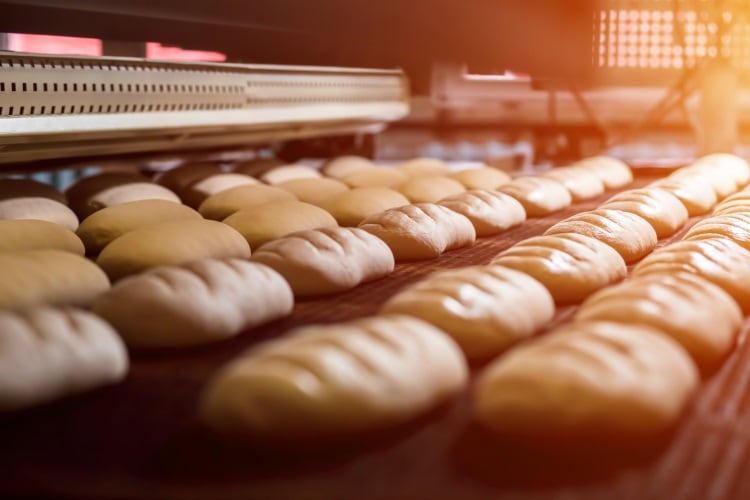According to Bulgarian systems integrator Mechatronics, a furnace machine for bread requires four temperature zones.
The first zone is especially powerful to compensate for the cooled conveyor belt and the relatively cool loaf entering the oven. At this step, steam is also injected into the furnace to give it that freshly-baked sheen. This is followed by three temperature-controllable baking zones. A perfectly timed conveyor belt throughout the process is also critical.
Rounding off the need is a human-machine interface (HMI) to configure the baking process, deliver temperature status of each zone and output any error status information.
Climate change
To create what it calls the optimal bread furnace machine for its clients, Mechatronics turned to Delta, a global leader in industrial automation. Mechatonics is the official supplier of Delta Motion, Drive, Control and Robotics products in Bulgaria, and is guided by the Taiwanese-headquartered company’s mission to nurture the development of smart manufacturing by providing clean and energy-efficient solutions.
Delta leverages its core competence in high-efficiency power electronics and its CSR-embedded business model to address key environmental issues. Since its establishment in 1971, the company has received numerous awards for its innovative technologies and been listed on the DJSI World Index of Dow Jones Sustainability Indices since 2011. In 2017, Delta was selected by CDP – formerly the Carbon Disclosure Project – for its Climate Change Leadership Level for the second consecutive year.
The optimal bread furnace
For the HMI, Mechatronics chose the Advanced HMI DOP-107WV from Delta’s DOP-100 Series.
This features a touch-based control panel on a flat, wipeable 16:9 7” colour TFT screen that, considering the dusty environment it operates within, is a great choice. It also boasts multilingual support specifically designed for its target market and user-friendly editing software that is easy to navigate. With several RS-485 capable COM ports, the DOP-107WV integrates seamlessly with other components on the furnace.
Mechatronics then included an MS300 Series inverter to control the conveyor. This AC motor variable frequency drive (VFD) also supports a RS-485 Modbus interface and is ideal for open-loop control of IM and PM motors.
Of course, the quality of the bake is ultimately defined by the furnace and the seven heating elements. The selection of reliable components, along with the careful programming, are critical to deliver a low-maintenance 250 kW furnace that can be operated 24/7.
Mechatronics selected Delta’s DTC1000 Temperature Controller as the main controller, with DTC2000 controllers used in parallel for the remaining six heaters. These are also connected to the Modbus. The auto-tuning function maintains temperature regulation, with sensors controlling the heating element in solid-state relays. Auto-tuning uses a training process to configure the closed-loop PID controller once the sensors and heaters are installed.
Raising a challenge is the dual heating and sensing of the last three baking zones. With one heater above the conveyor and the other below, each needs to be set to a different temperature. However, Mechatronics found spare outputs from the Delta Temperature Controllers can be used to link to relays for audible and visible alarm signals. These signals are also replicated in the DOP-107WV HMI.
Closely coupled with the quality of the bake is the speed control of the conveyor belt. Here, Mechatronics elected that the MS300 VFD is linked to an inductive proximity sensor that is easy to clean and remains accurate in the dusty environment. The built-in programmable logic controller (PLC) of the MS300 is configured to calculate the conveyor speed and is continuously compared to the setpoint defined in the HMI. Human input is only needed set the desired baking time, the required temperature and then to press ‘run’ to start baking.
Combining the skill of bakers and engineers
“Most people would assume that baking bread is very simple. On the contrary, the bread furnace project has highlighted the skill required of both bakers and engineers to create a machine that delivers the perfect loaf,” said Victor Ogedegbe, field application engineer at Dela.
“The auto-tuning function of the DTC1000/2000 played a large part in ensuring that bakers can deliver a quality product every batch, by providing excellent temperature control.”
Toma Draganov, automation engineer at Mechatronics, added, “Construction of the bread furnace was simplified by the availability of components that are interoperable and fulfilled the requirements demanded by our customers.
“Accurate temperature control was most critical for us, and Delta’s support was essential in configuring the DTC1000/2000 auto-tuning function. This assistance contributed to the project moving from the initial design stage to full production in just seven months.”


